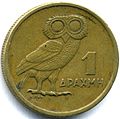Modern drachma
| ||||||||||||||||||||||||||||||||||||||||||||||||||||||||||||||||||||||||||||||||||||||||||||||||||||||||||||||||||||||||||||||||||||||||||||||||
Read other articles:

Matthias Jakob SchleidenLahir(1804-04-05)5 April 1804Hamburg, JermanMeninggal23 Juni 1881(1881-06-23) (umur 77)Frankfurt am Main, JermanKebangsaanJermanAlmamaterHeidelbergDikenal atasPenemu teori selKarier ilmiahBidangBotaniInstitusiUniversity of Jena, University of DorpatSingkatan penulis (botani)Schleid. Matthias Jakob Schleiden (5 April 1804 – 23 Juni 1881) adalah seorang ahli botani asal Jerman yang menjadi salah seorang penemu teori sel bersama dengan Theodor Schwa…

American WWII glider CG-4/Hadrian CG-4A Role Military gliderType of aircraft Manufacturer Waco Aircraft Company Built by Cessna Ford Gibson Appliance First flight 1942 Primary users United States Army Air ForcesRoyal Air ForceRoyal Canadian Air ForceUnited States Navy Number built >13,903 Variants Waco CG-15 The Waco CG-4 was the most widely used American troop/cargo military glider of World War II. It was designated the CG-4A by the United States Army Air Forces,[1] and given th…

Flemish writer and poet Maurice GilliamsBorn(1900-07-20)20 July 1900AntwerpDied18 October 1982(1982-10-18) (aged 82)AntwerpOccupationwriter, librarianNationalityBelgianNotable worksElias, or the struggle with the nightingalesWebsitewww.mauricegilliams.nl Maurice, Baron Gilliams (Antwerp, 20 July 1900-Antwerp, 18 October 1982) was a Flemish writer and poet. Life and work Gilliams was the son of printer Frans Gilliams, and he learned to be a typographer. On 27 August 1935, he married Gabriël…

2020 edition of the FIFA Club World Cup 2020 FIFA Club World CupFIFA Club World Cup Qatar 2020presented by Alibabaكأس العالم للأندية لكرة القدم قطر 2020Tournament detailsHost countryQatarCityAl RayyanDates4–11 February 2021Teams6 (from 5 confederations)Venue(s)2 (in 1 host city)Final positionsChampions Bayern Munich (2nd title)Runners-up UANLThird place Al AhlyFourth place PalmeirasTournament statisticsMatches played8Goals scored12 (1.5 per match…

关于与「內閣總理大臣」標題相近或相同的条目页,請見「內閣總理大臣 (消歧義)」。 日本國內閣總理大臣內閣總理大臣紋章現任岸田文雄自2021年10月4日在任尊称總理、總理大臣、首相、阁下官邸總理大臣官邸提名者國會全體議員選出任命者天皇任期四年,無連任限制[註 1]設立法源日本國憲法先前职位太政大臣(太政官)首任伊藤博文设立1885年12月22日,…

此条目序言章节没有充分总结全文内容要点。 (2019年3月21日)请考虑扩充序言,清晰概述条目所有重點。请在条目的讨论页讨论此问题。 哈萨克斯坦總統哈薩克總統旗現任Қасым-Жомарт Кемелұлы Тоқаев卡瑟姆若马尔特·托卡耶夫自2019年3月20日在任任期7年首任努尔苏丹·纳扎尔巴耶夫设立1990年4月24日(哈薩克蘇維埃社會主義共和國總統) 哈萨克斯坦 哈萨克斯坦政府與�…

American library association 2022 ALSC President's Program with President Lucia M. GonzalezThe Association for Library Service to Children (ALSC) is a division of the American Library Association. ALSC has over 4,000 members, including children, experts in children's literature, publishers, faculty members, and other adults. The Association has nearly 60 active committees and task forces, including programs for youth, publishing resources and journals, evaluating and awarding media for children.…

Cet article est une ébauche concernant un stade de football et la Russie. Vous pouvez partager vos connaissances en l’améliorant (comment ?) selon les recommandations des projets correspondants. Stade de Kaliningrad Стадион КалининградGénéralitésSurnom Arena BaltikaAdresse Kaliningrad, RussieConstruction et ouvertureDébut de construction 2015Ouverture 12 mai 2018 (6 ans)Architecte Wilmotte & associésUtilisationClubs résidents Baltika KaliningradPropriét…

2015 NCAA Division I FBS football rankingsSeason2015Bowl season2015–16 bowl gamesPreseason No. 1Ohio State[1] End of season championsAlabamaConference with mostteams in final AP pollBig Ten (6)NCAA Division I FBS football rankings ← 20142016 → Two human polls and a committee's selections comprised the 2015 National Collegiate Athletic Association (NCAA) Division I Football Bowl Subdivision (FBS) football rankings, in addition to various publications' preseason pol…

Pour les articles homonymes, voir Sang (homonymie). Au contact du dioxygène, le sang doit sa couleur rouge à l’hémoglobine. Sang humain observé (grossissement :1000) en microscopie à fond noir. Début de coagulation (en haut à droite). De gauche à droite : globule rouge, plaquette sanguine et globule blanc. Le sang est un liquide biologique vital qui circule continuellement dans les vaisseaux sanguins et le cœur, notamment grâce à la pompe cardiaque. Il est composé d'un fluide …

Economic forum of Asia–Pacific nations APEC redirects here. Not to be confused with AIPAC, APAC, or OPEC. Asia-Pacific Economic Cooperation Member economies of APECHeadquarters SingaporeTypeEconomic meetingMembership 21 economies Australia Brunei Canada Chile China Hong Kong Indonesia Japan Malaysia Mexico New Zealand Papua New Guinea Peru Philippines Russia Singapore South Korea &…

Suami-Suami Masa Kini 2Genre Drama Komedi SkenarioTim MVPCeritaTim MVPSutradara Ody Harahap Andrianto Sinaga Pemeran Wulan Guritno Ringgo Agus Rahman Karina Suwandi Marcell Darwin Tanta Ginting Lagu pembukaKereta Malam oleh Anak Badung, Camel & GoodgripLagu penutupKereta Malam oleh Anak Badung, Camel & GoodgripPenata musikOpingNegara asalIndonesiaBahasa asliBahasa IndonesiaJmlh. musim2Jmlh. episode8ProduksiProduser eksekutif Monika Rudijono Anita Whora Produser Raam Punjabi Tia Hen…

18°42′0″N 42°13′50″E / 18.70000°N 42.23056°E / 18.70000; 42.23056 (جبل الصهلاء) جبل الصهلاء الموقع السعودية إحداثيات 18°41′59″N 42°13′50″E / 18.699755555556°N 42.230672222222°E / 18.699755555556; 42.230672222222 الارتفاع 2837 متر[1] تعديل مصدري - تعديل جبل الصهلاء من جبال السروات، أحد أع�…

Election in Tennessee Main article: 1932 United States presidential election 1932 United States presidential election in Tennessee ← 1928 November 8, 1932[1] 1936 → All 11 Tennessee votes to the Electoral College Nominee Franklin D. Roosevelt Herbert Hoover Party Democratic Republican Home state New York California Running mate John Nance Garner Charles Curtis Electoral vote 11 0 Popular vote 259,473 126,752 Percentage 66.49% 32.48% County…

Highest trim level for GMC vehicles Not to be confused with Denali. This article is about the nameplate from GMC. For other uses, see Denali (disambiguation). DenaliProduct typeAutomobilesOwnerGeneral MotorsProduced byGeneral MotorsCountryU.S.Introduced1998; 26 years ago (1998)Websitegmc.com/denali Denali is a nameplate used by GMC for its highest trim level on its vehicles. Vehicles with the Denali trim option carry list prices up to 47% higher than base models. Prices ra…

Di seguito è riportata l'evoluzione del collegio cardinalizio durante il pontificato di Pio XII (2 marzo 1939-9 ottobre 1958) e la successiva sede vacante (9 ottobre 1958-28 ottobre 1958). Indice 1 Evoluzione in sintesi 2 Composizione per paese d'origine 3 Composizione per concistoro 4 Elenco degli avvenimenti 5 Note 6 Voci correlate 7 Collegamenti esterni Evoluzione in sintesi Dopo l'elezione del cardinale Eugenio Pacelli il collegio dei cardinali era costituito da 61 cardinali. Pio XII ha cre…

Basilika Notre-Dame de FourvièreBasilika Bunda Maria dari FourvièreBasilique Notre-Dame de FourvièrePemandangan basilika dari Vieux-LyonBasilika Notre-Dame de Fourvière45°45′45″N 4°49′21″E / 45.76250°N 4.82250°E / 45.76250; 4.82250Lokasi8 Place de Fourvière, LyonNegaraPrancisDenominasiKatolikTradisiRitus RomawiSitus webfourviere.orgSejarahDedikasiMaria, Ibu Yesus (dengan gelar Bunda Maria dari Fourvière)ArsitekturStatusBasilika minorStatus fungsionalAkti…

1 Tawarikh 18Kitab Tawarikh (Kitab 1 & 2 Tawarikh) lengkap pada Kodeks Leningrad, dibuat tahun 1008.KitabKitab 1 TawarikhKategoriKetuvimBagian Alkitab KristenPerjanjian LamaUrutan dalamKitab Kristen13← pasal 17 pasal 19 → 1 Tawarikh 18 (atau I Tawarikh 18, disingkat 1Taw 18) adalah bagian dari Kitab 1 Tawarikh dalam Alkitab Ibrani dan Perjanjian Lama di Alkitab Kristen. Dalam Alkitab Ibrani termasuk dalam bagian Ketuvim (כְּתוּבִים, tulisan).[1][2] Teks …

Medication of the opioid type, patented 1972 Tramadol Clinical dataPronunciationtra' ma doll Trade namesUltram, Zytram, Ralivia, others[1]AHFS/Drugs.comMonographMedlinePlusa695011License data US DailyMed: Tramadol Pregnancycategory AU: C[2] DependenceliabilityLow–moderate[3]Routes ofadministrationBy mouth, intravenous (IV), intramuscular (IM), rectalDrug classOpioid analgesic[4]ATC codeN02AX02 (WHO) N02AJ13 (WHO)Legal statusLeg…

NetverseURLhttps://netverse.id Tipelayanan hosting video, situs web dan layanan streaming video PendaftaranOpsionalBahasaBahasa IndonesiaPemilikPT Net Media Digital (Net Visi Media)Berdiri sejak20 Mei 2022; 2 tahun lalu (2022-05-20)NegaraIndonesia StatusAktif Netverse (digayakan sebagai NET.VERSE) adalah sebuah layanan pengaliran video milik Net Visi Media anak perusahaan Indika Group.[1] Aplikasi Netverse menyediakan beragam konten video dari program-program NET., mulai dari gelar …
















